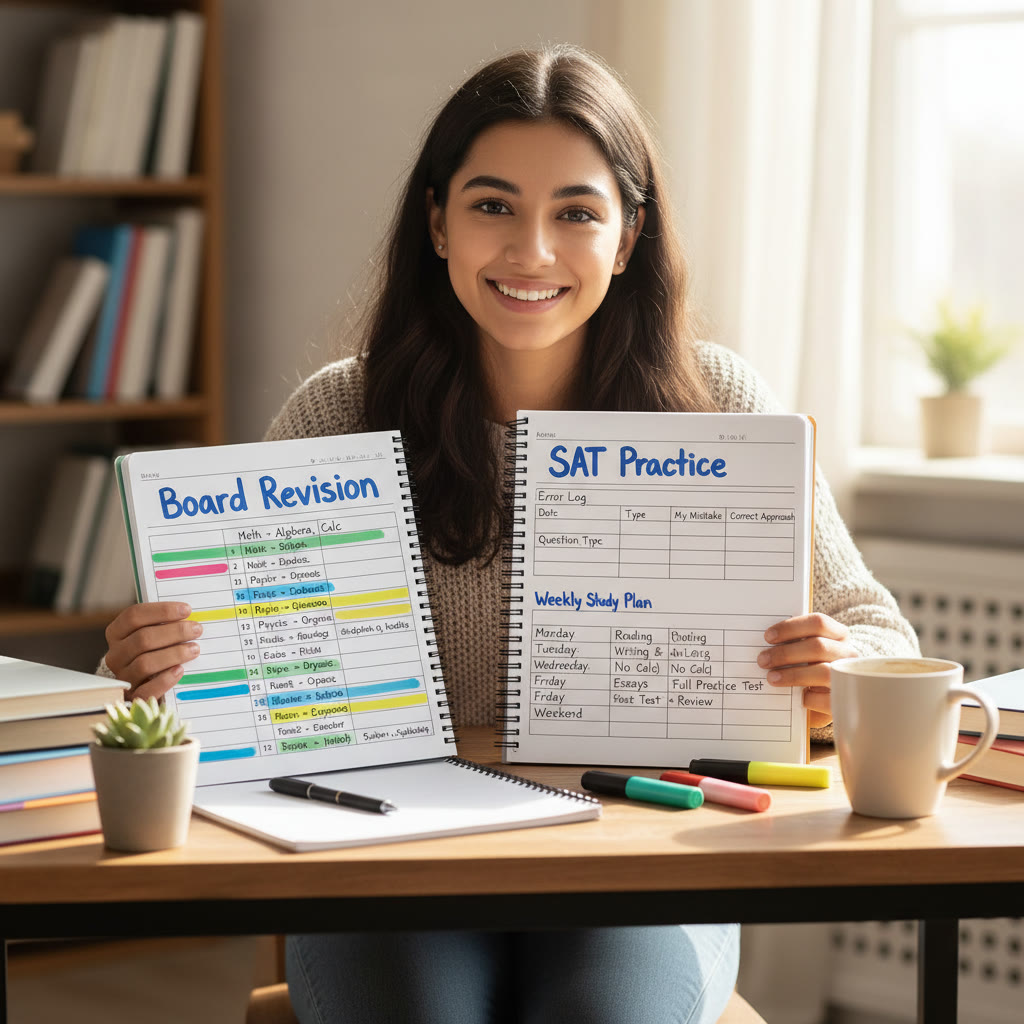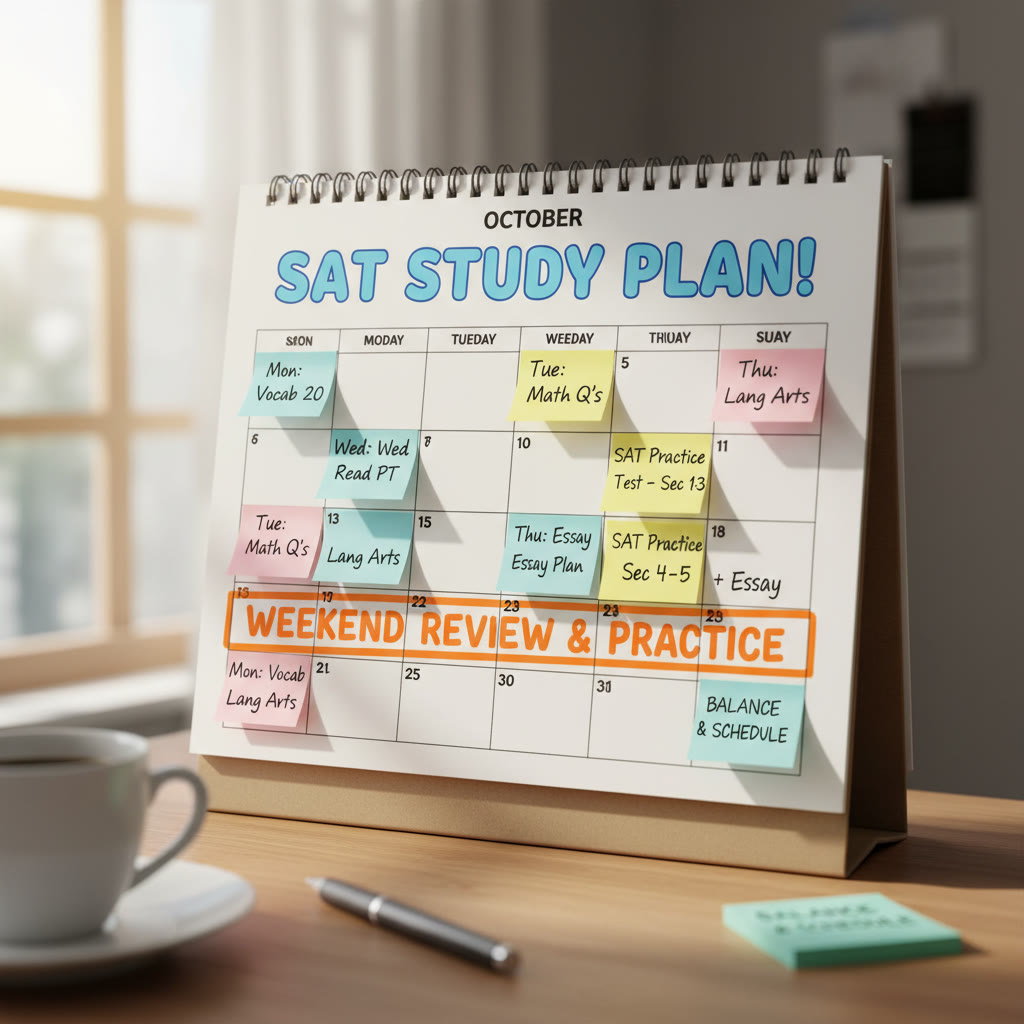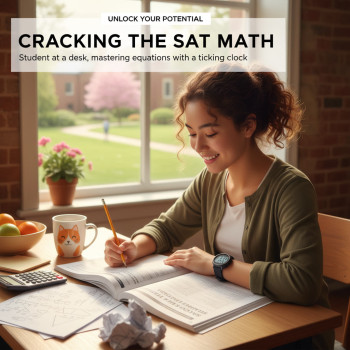How to Prepare for the SAT During Board Exams: A Calm, Smart Plan
Balancing board exams and SAT preparation feels like juggling two burning candles at once. You want to do well in both, and the pressure can make everything feel urgent. The good news: you don’t have to choose. With small, consistent choices and a strategy that respects your energy and school commitments, you can make serious progress on the SAT without sacrificing board performance.
This guide is written for realistic students who have classes, schoolwork, and life to manage. You’ll find practical daily habits, time-saving methods, a six-week sample plan, and ways to get targeted help—like putting Sparkl’s personalized tutoring in your corner when needed—without turning your life into a constant cram session.
Start with the right mindset
First, breathe. High-stakes tests feel like they define everything, but steady, focused practice moves the needle far more than frantic last-minute studying. Think of SAT prep during boards as strategic micro-investments: short, high-value sessions that build skill and confidence.
Adopt three small mindset shifts:
- Quality over quantity: 30 well-aimed minutes beat three unfocused hours.
- Consistency beats intensity: daily small wins compound into major gains.
- Trade overlap, not time: use cross-benefits between board subjects and SAT prep.
Understand what really matters on the SAT
Before you write a schedule, know the battlefield. The SAT has four main components: Reading, Writing & Language, Math (No Calculator), and Math (Calculator), with a maximum score of 1600. The test rewards accuracy, strategic time use, and familiarity with the question types. That means targeted practice and regular timed stretches will return more than aimless review.
Focus areas that give the biggest ROI
- Timed problem solving — build stamina for 65–80 minute sections.
- High-frequency grammar rules in Writing & Language (comma rules, parallelism, verb tense).
- Algebra and data analysis in Math — these show up often.
- Passage reading speed and evidence-based answers for Reading.
Make a realistic time budget
If you’re studying for boards, your available SAT time is limited. Here are practical blocks that fit around school study:
- Daily micro-sessions: 20–40 minutes on weekdays.
- Longer practice: 2–4 hours on weekends, ideally a full-length SAT practice test every 1–2 weeks.
- Recovery and rest: at least one evening off per week to reset.
Below is a sample weekly time allocation you can adapt based on how busy your board schedule is.
| Day | Board Study | SAT Focus | Time |
|---|---|---|---|
| Weekday (Mon-Fri) | Homework, revision | Daily micro-session: targeted practice (grammar, 10 math problems, or reading practice) | 20–40 minutes |
| Saturday | Board revision, sample papers | Timed Section Practice or full practice test (alternate weekends) | 2–4 hours |
| Sunday | Catch-up and rest | Review mistakes, light targeted study, plan for week | 1–2 hours |
Six-week example plan: fit SAT prep into board season
This plan assumes you have boards ongoing and can commit about 30 minutes on weekdays and 3 hours on one weekend day. It’s designed to build skill without burnout.
- Week 1: Diagnostic + fundamentals
- Take a timed diagnostic (condense to one or two sections if you can’t do a full test).
- Identify one weak area to attack in Weeks 2–3.
- Start a 10-minute nightly vocab/reading habit: annotate one short passage and summarize.
- Weeks 2–3: Core skill building
- Math: focus on algebra and problem solving; practice 10 targeted problems daily.
- Writing: review the top 10 grammar rules and do 15-minute drills.
- Reading: practice one short passage daily; focus on main idea and evidence.
- Week 4: Timed practice and endurance
- Take a timed Math section and/or Reading section under exam conditions on a weekend.
- Analyze mistakes carefully, add them to an error log.
- Week 5: Strategy and fine-tuning
- Work on pacing strategies (e.g., passage triage, grid-in strategy).
- Begin allowing calculator and no-calculator strategy sessions on different days.
- Week 6: Review, confidence, and light practice
- Do a light review of error log and high-yield rules.
- Take no more than one full practice test if you already feel balanced.
- Prioritize sleep, nutrition, and stress reduction heading into exams.
Concrete daily routines that actually work
When time is scarce, the way you use it matters. Here are three micro-routines you can rotate depending on the subject of the day.
Routine A — 30 minutes: Math focus
- 5 minutes: Quick review of a mistaken problem or formula.
- 20 minutes: Solve 6–8 targeted problems on one content area (algebra, functions, data analysis).
- 5 minutes: Log errors and note one tactical takeaway (e.g., remember to isolate variable first).
Routine B — 30 minutes: Writing & Language
- 10 minutes: Read a short passage and highlight sentence-level errors.
- 15 minutes: Drill 10 official practice questions.
- 5 minutes: Summarize a grammar rule to cement it.
Routine C — 30–40 minutes: Reading and evidence
- 5 minutes: Preview strategy—scan passage to note structure.
- 25–30 minutes: One passage under timed conditions, then quick review of incorrect answers focusing on evidence.
Smart ways to combine board study with SAT prep
The most efficient students repurpose board study for SAT value. Here are practical crossovers:
- If you’re analyzing passages in English or literature for boards, practice summarizing the author’s argument in one sentence—this trains SAT reading skills.
- Use math problems from board topics that align with SAT algebra, geometry, or statistics as additional SAT practice. Re-solve problems with SAT timing and answer format.
- Vocabulary and essay practice for boards doubles as Reading practice—practice choosing precise words and summarizing passages concisely.
Practice tests: when and how to take them
Full practice tests are invaluable for pacing and stamina, but during boards you may not be able to do many. Here’s how to get the value without overcommitting.
- Alternate approach: take one full practice test every 2–3 weeks, then in between take timed sections (one Reading or two Math sections) on weekends.
- Simulate test conditions: quiet room, same time of day you’ll test, no phone. Wear noise-cancelling headphones if your environment is noisy.
- After every test or timed section, spend at least as much time reviewing as you spent taking it. The review is where improvement happens.
Keep an error log and make it useful
An error log turns mistakes into a curriculum. Don’t just mark answers wrong—capture patterns.
- Record: question type, content area, why you missed it (concept error, careless, timing), and the correct approach.
- Review: glance at new mistakes daily and do a weekly scan for recurring themes.
- Action: assign one targeted micro-session per week to fix the most common error type.
Test-day skills you can practice in 10 minutes
Tiny rituals reduce stress and boost efficiency on exam day. Practice these ahead of time so they become automatic:
- Bubble strategy: practice filling answer sheets quickly and accurately to avoid lost time on paper tests.
- Passage triage: for Reading, scan first 30 seconds to identify structure and difficulty; do the easiest passages first if that’s your strategy.
- Grid-in practice: practice bubbling and estimating answers to avoid calculator overuse and save time.
Managing stress, sleep, and nutrition during board + SAT season
Academic performance is not just cognitive work—it’s biological. Sleep, food, and stress-management practices compound into sharper thinking and better recall.
- Sleep: aim for 7–9 hours. Even during busy periods, prioritize consistent bedtimes.
- Nutrition: favor balanced meals with protein, whole grains, and greens; keep small snacks like nuts for quick energy during study blocks.
- Movement: short 10–20 minute walks or light exercise increase focus, especially when you’ve been sitting for long study sessions.
- Mental resets: try 5-minute breathing, short stretches, or a quick music break to lower cortisol and return to work refreshed.
How to use targeted help wisely
When time is limited, targeted help accelerates progress. If you choose tutoring, pick options that provide focused, efficient gains.
- Short-term goals: ask a tutor to diagnose the single highest-leverage weakness and coach you on corrections until it’s stable.
- 1-on-1 guidance: for students juggling boards, individualized attention helps you use limited study time on the most impactful areas.
- Tailored study plans: a coach can create a plan that fits your board exam schedule and prevents wasted hours on material you already know.
For example, Sparkl’s personalized tutoring offers these kinds of benefits: 1-on-1 guidance to focus your limited time, tailored study plans that consider board commitments, expert tutors who know how to prioritize high-return skills, and AI-driven insights that spot patterns in mistakes. That kind of targeted support can be the difference between spinning wheels and steady progress when every minute of study counts.
Shortcuts that actually work (and ones to avoid)
Workable shortcuts
- Active recall flashcards for grammar rules and vocabulary—two minutes a day keeps rules fresh.
- Pretend tests: take single sections as if they were the whole test to keep pacing sharp without committing a whole day.
- Study swaps: swap a board practice question with an SAT-style approach—solve it SAT-style and time yourself.
Pitfalls to avoid
- Endless content review without timed practice—knowing concepts but not executing under time hurts scores.
- Trying to learn too many new strategies at once—focus on mastering one pacing strategy before adding another.
- Neglecting board responsibilities—boards are immediate priorities and missing the foundation there weakens long-term outcomes.
Sample error log entry (template)
Use this short template to convert a missed question into a learning moment.
| Field | Example |
|---|---|
| Question type | Algebra: linear equation |
| Mistake reason | Careless sign error |
| Fix | Check each rearrangement step, underline signs, rinse and repeat |
| Follow-up | Do 3 similar problems in next practice session |
When to get extra help and how to ask for it
If you’re plateauing despite consistent effort, that’s a sign to reach out. Good questions to ask a tutor or mentor:
- What are the three things I should stop doing that waste time?
- Which question types am I most likely to miss under time pressure?
- Can you show me a faster way to approach X problem? (Ask for a demonstration and a practice set.)
Targeted tutoring—like Sparkl’s personalized tutoring—can compress months of progress into weeks by eliminating inefficient habits and focusing your practice. Their approach blends 1-on-1 attention, tailored study plans, expert tutors, and AI-driven insights to help you make each limited study minute count.
Keep perspective: boards first, SAT second—but steady
When boards are happening now, it’s reasonable to accept a temporary slowdown in SAT prep. The goal is not to master everything at once; the goal is to preserve momentum. Small, deliberate actions add up:
- Do 20–40 minutes of SAT-focused work most weekdays.
- Use weekends for timed practice and review without compromising rest.
- Leverage overlap between board studies and SAT skills.
Remember: progress doesn’t need to be dramatic every day. It’s the quiet accumulation of targeted improvements that produces a higher SAT score and, just as importantly, better test-taking confidence.
Two last-minute tools you can adopt tonight
- Create a five-item nightly checklist: (1) one 20-minute SAT micro-session, (2) review one board concept, (3) hydrate and eat protein, (4) 10-minute walk, (5) lights out at a consistent time.
- Set up an error log file and add the next three mistakes you make—review them every Sunday for ten minutes.
Closing thoughts: small choices, steady gains
Preparing for the SAT during board exams is a balancing act, but it’s also an opportunity to build disciplined habits that serve you beyond exams. Approach your prep with kindness, structure, and a focus on high-leverage activities. Use targeted help to accelerate when you need it—1-on-1 guidance and tailored study plans, such as those offered by Sparkl’s personalized tutoring, can be especially efficient during busy seasons.
Above all, respect your energy. Sleep, solid nutrition, and short recovery breaks are not luxuries—they are performance enhancers. Keep your study sessions short and meaningful, review mistakes thoroughly, and let consistency be your competitive advantage. You can get through your boards and still make meaningful progress on the SAT. One focused, calm step at a time.
























No Comments
Leave a comment Cancel